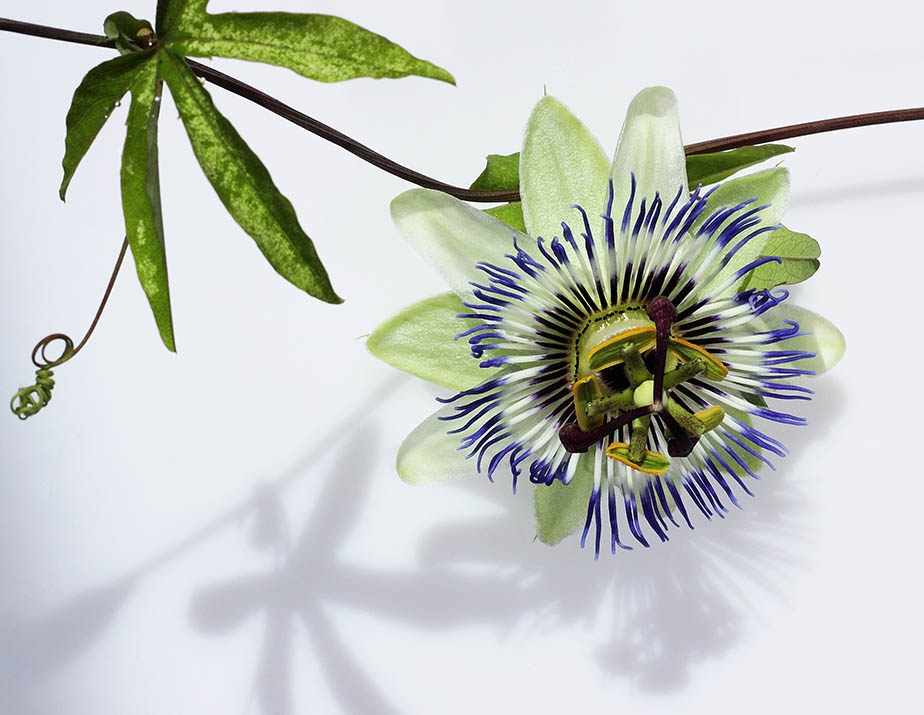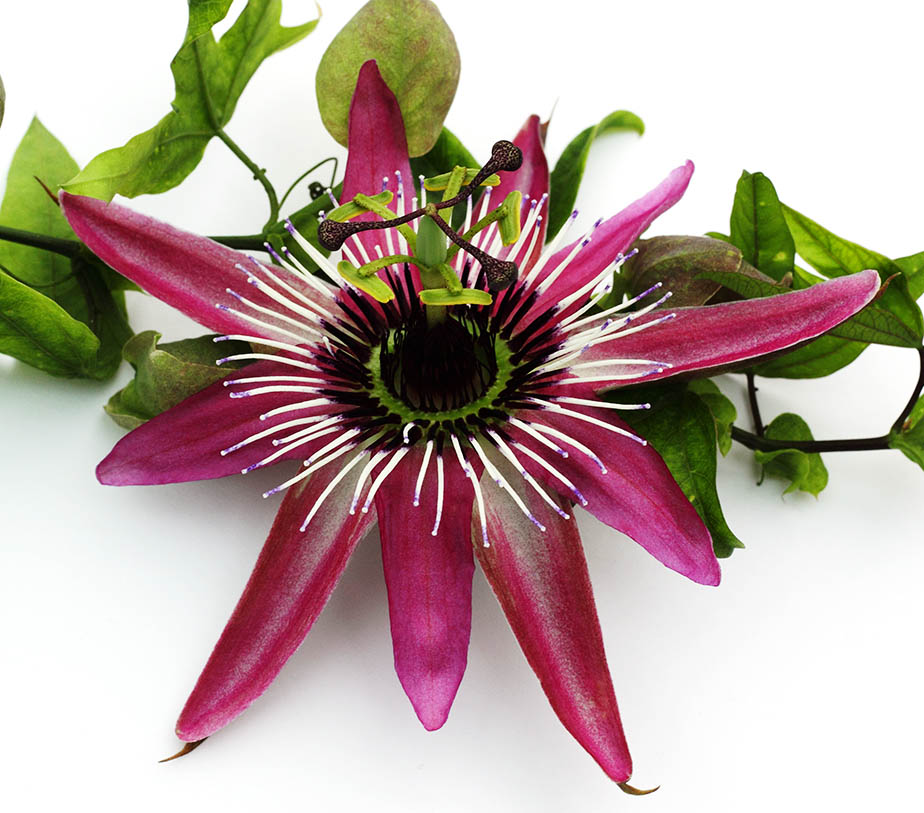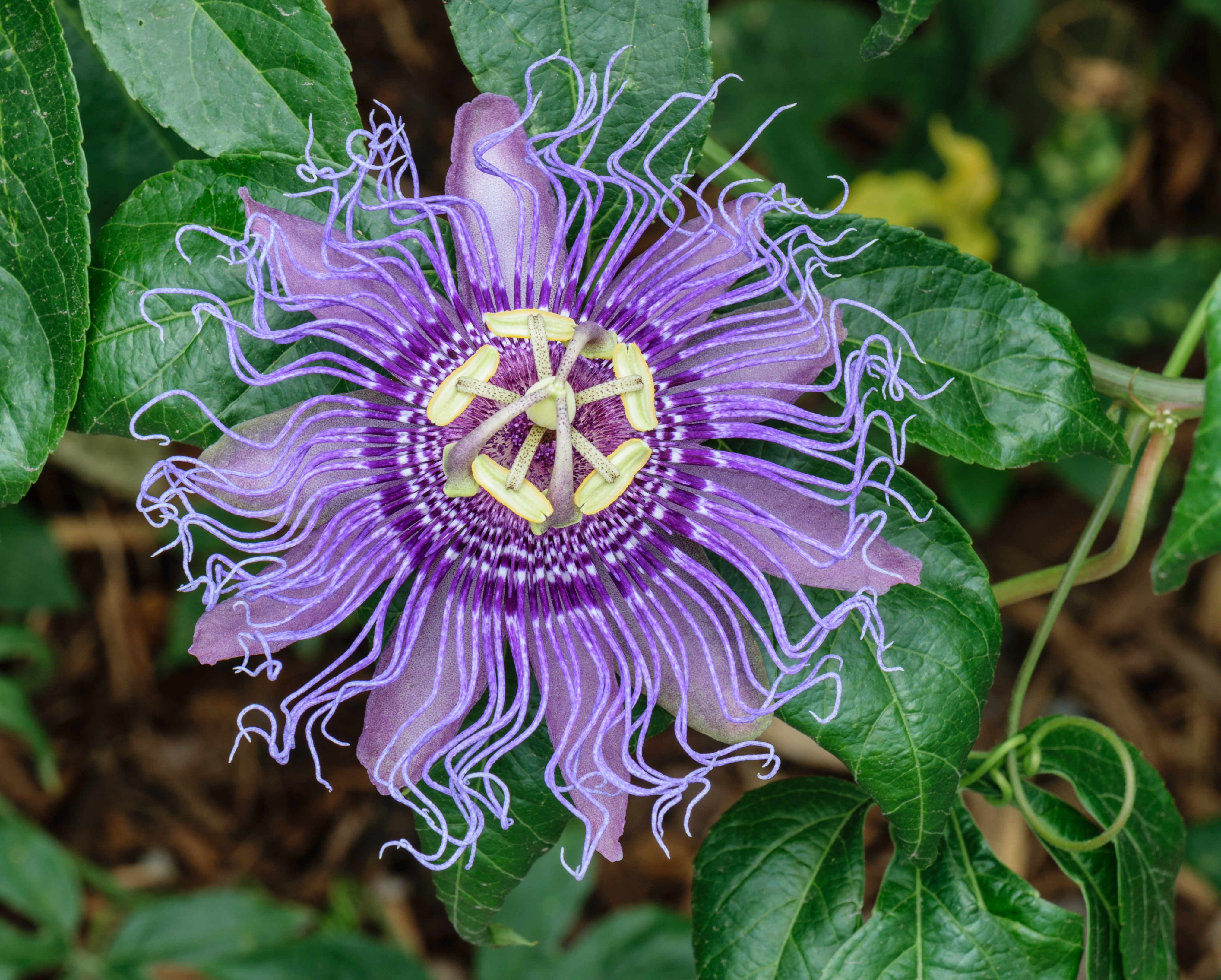The first time I saw a passion-flower was many years ago, on a holiday in England. It was the usual Passiflora ‘caerulea’, the blue passion flower. It seemed impossibly exotic for a flower growing in the UK at that time. And for someone still living in Scotland, with the colder winters there, the idea of growing one seemed to be pure fantasy.
A few years later I found some plants of ‘caerulea’ for sale in an Edinburgh shop and just couldn’t resist buying one – and, of course, taking lots of photographs of the extraordinary flowers. Later on, I managed to buy a plant of Passiflora ‘Amethyst’ (top photo) and became thoroughly hooked on these beautiful climbers.
For photography they’re a wonderful subject. From further away, the flower is graceful. Every part of it is elegant. There’s the shape of the petals and the way the strands of the corona are held in a ring. And then there’s the sculptural quality of the reproductive parts of the flower.
If you come closer in, there are plenty of details to photograph. You have the way the strands of the corona change from dark purple at the centre, to white, to blue at the outside. You’ll also see the dark purple mottling of spots that covers the three ‘styles’, with more, less pronounced purple spots on the five green ‘filaments’ that hold the anthers.
The plants in these pictures were in pots sitting on a tiled conservatory floor, so I used a large sheet of white paper to give a plain background. Because the plants can be an untidy mass of leaves and stems, each flower was gently disentangled from the rest of the plant and the stem holding it was stretched across the white background. This isolated the flowers, got rid of background distractions, and allowed a bolder image to be made.
For the photograph at the bottom, I decided to simplify things further and removed a few of the leaves on that stem. (Cruelty to plants!) Then I placed the flower, with its leaf and the little tendril, in a way that would create a composition with the shadows that they cast.
Before taking close-up photographs like this, it’s a really good idea to check that there’s no dust or bits on your backdrop and that there aren’t any wee beasties in the plant (unless you want them there). It’s frustrating to open an image in Photoshop just to find some tiny critter practically waving and shouting, ‘Yeah, I’m here!’ And if you have pets, don’t forget to check for hairs. I have two cats, one long-haired, and it’s just amazing to see where those fine hairs can get to. (Thank goodness for Photoshop’s heal and clone tools!)
I’m always on the lookout for plants that will make good photographs. Many of the plants in the garden here are chosen this way. So you can imagine my delight when we moved into this house and I discovered that the neighbours had a blue passion-flower that was sneaking under the fence into our garden. There was great excitement when the first flowers opened. Sadly, the plant disappeared. I don’t know if it was due to a very cold winter or if the neighbours decided to get rid of it.
As you would expect, I soon got some plants of my own and the two you see in the photos here are currently living in our conservatory. (I’m trying to learn not to over-water them. They like better drainage than I had thought and I’ve nearly lost them a couple of times!)
In the garden, I’m trying ‘Constance Elliot’, which has pure white flowers and is said to be scented. It’s growing over an arbour and seems to be doing well but I don’t know if it’s hardy enough to come through a cold winter. (Mulching it should help.) It hasn’t flowered yet – that’s something to look forward to next year.
If you’re reading this from somewhere warmer than the UK, passion-flowers may be a common sight for you. You may have some of the more tender varieties that, here in England, I can only dream of. I wonder if there are plants that won’t grow where you are, that you really wish you could have? Do let me know in the comments!


They are really wonderful, dear Ann! Little wonders of nature!
LikeLiked by 2 people
Thank you, Pepix! I am delighted that you like them! 🙂
LikeLiked by 1 person
‘Amethyst’ is stunning and captured so beautifully in your photo!
LikeLiked by 1 person
Thank you Liz! I’m glad you like it! 🙂
LikeLiked by 1 person
Love your flower photographs. You’re very talented!
LikeLiked by 1 person
Thank you for your lovely comments, Laurel! I’m so happy that you like them! 🙂
LikeLike
Hi Ann – Beautiful blooms – never seen anything quite like it here in Florida. I think I may have seen a variety of Passion Plant at one of the botanical gardens in Orlando but I did not capture an image. Thought I would link a Passiflora incarnata that is considered native to Florida. I would love to grow one of these – probably the deer would eat them!

LikeLiked by 1 person
Wow, Syd, that is gorgeous! I’m just imagining what it must be like to have that passionflower growing outside in the garden……might be worth your while to give it a try. (I think passionflowers get pretty big – might need the deer to keep it in check!!) I would love one of those in my conservatory and I’m beginning to think that the conservatory might need elastic sides……
LikeLike
Stunning! My next-door neighbour attempted growing a passion flower against his wall, but conditions in our West Yorkshire gardens, and direction, put an end to this after a year. I can’t grow clematis either, but other neighbours round the corner can. It’s surprising what a slightly different aspect can do.
LikeLiked by 1 person
Thank you Jill! I think a hard winter here can kill off passion-flowers very easily. Every area seems to have different microclimates – my Mum’s garden nearby had great big healthy passionflowers that did well every year, producing lots of fruit too. (But the fruit didn’t taste of much, according to Hubby, who just had to give them a try!)
LikeLiked by 1 person
Beautiful images.
LikeLiked by 1 person
Thank you for your kind comment!
LikeLike
[…] Well, I’m going to go and take some more passionflower photos. And I’m hoping that ‘Constance Elliot’ will survive the next winter and provide more lovely flowers (and the opportunity for more photographs). You can see my earlier post about passionflowers here. […]
LikeLike